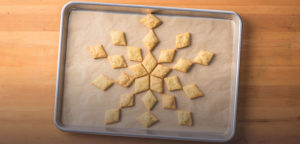Once halls are decked, the presents are under the tree, and the stockings are hung by the chimney with care, it’s time to actually relax and enjoy some long awaited quality time with friends and family this season. When you know how to create a festive holiday cheese board, not only will you always be ready to host a holiday event of your own, you won’t have to stress over what to take to that next impromptu ugly sweater party.
If you don’t know where to start (or maybe you just don’t know how to make your cheese board jolly and bright), don’t fret—we’ve broken it all down for you so you can create the perfect holiday cheese board and check one more thing off the to-do list that seems to always grow longer this time of year.
Don’t have time to read through this whole guide right now? Bookmark it for later and go apply these tips now:
- Stock up with fresh ingredients.
- Use as many colors of the rainbow as possible.
- Feature your cheese as the stars of the board.
- Fill in the gaps with all the food groups.
- Grab our cheat sheet to make it even easier.
How to Create a Festive Holiday Cheese Board
Step 1: Shop for your ingredients
No cheese board exists without the cheese, so selecting the perfect cheese is your first and most important step. Since the cheese is the main attraction, you’ll want a variety of textures and tastes. We recommend Copper Kettle Parmesan, Smoky Pepper Rubbed Fontina and a wedge of classic aged Cello Parmesan to build your holiday cheese board. These three offer the nice balance of sweet, smokey, and savory that your guests will love.
It’s also a great idea to pick up several cheese flights to take the guesswork out of the cheese selection process and be prepared to party in an instant!
What else do you put on a festive cheese board?
So you’ve got your cheese. Now you might be asking yourself how to get from a tasty few wedges to one of those extravagant and Pinterest perfect cheese boards you see on Instagram. Get your shopping list out and make sure to pick up one or two items for each of the following categories:
- Fresh Fruits
Fresh fruit on your cheese board will not only add pops of color, it works to infuse some acid and delicate sweetness to the spread. Look for seasonal fruits like seedless grapes, juicy orange slices, crisp apples and pears. You can also go the gourmet route and incorporate pomegranate or figs. For something really unique, thinly slice and stack starfruit to add an extra special and festive touch. - Something Sweet
You may not think of decadent dark chocolate, gingerbread, or carmels for your display, but the sweetness will nicely balance the rest of the choices on your savory holiday cheese board and add some indulgence. Candied nuts are also a traditional Christmas treat! - A Touch of Salt
Your cheese board is better when it’s balanced, so pick a salty element like pretzels, castelvetrano or kalamata olives that will enhance the saltiness within the cheeses and temper those sweeter elements above. Don’t be shy when it comes to inviting carbs to the board when you’re adding your salt. There are lots of options here, like breadsticks, hearty grain crackers, and buttery thin crisps. Also, consider some gluten-free options to be inclusive of your guests. - Bring the Heat
Spiced nuts, like cracked pepper peanuts, habanero pistachios, or the classic smokehouse almonds all earn a spot for the bit of spice they bring to your holiday cheese board. We’re also fans of hot mustard, which leads us to the last element. - Finish the “Spread”
Flavored mustard, spiced honey, and Christmas fig spread all make ideal additions to a holiday cheese board. Seasonal jelly flavors are endless, you have lots of choices here. Garnish with sprigs of rosemary for that extra holiday flair.
Pro tip: For a truly festive touch, use a red and green theme for your ingredients—like fresh herbs, green grapes, red and green apples, and red berries.
Making a charcuterie board? You can scale back on the saltiness from crackers and pretzels when you have meats like salami and pepperoni to balance that out. Use our charcuterie board guide here to help you.
Step 2: Assemble the pieces
Now that you have all the ingredients for your holiday cheese board, it’s time to have some fun creating your own unique display.
A traditional wooden cheese board (or two) is naturally a go-to for your surface foundation, but there are other fun options you can experiment with! Have a chalkboard base? Use a chalk marker to trace the outline of a Christmas tree, holiday wreath, or star. Then scatter the greens and place your ingredients you shopped for above. Now, take your smaller elements like berries and place them like little ornaments around the assortment. If you’re using the starfruit, you can add that as your tree topper.
Another simple option is to take a cookie sheet and flip it upside down. Cover it with a holiday parchment or wax paper and voila—you have an instantly festive canvas for your creation.
Step 3: Add some festive accents
Your holiday cheese board is supposed to be fun, so get creative. If you have any large metal cookie cutters, use them as bases to hold the nuts or candies. If you have any small ornamental dishes in holiday shapes or colors, they’ll make the perfect holders for olives, grapes and spreads.
Not feeling so creative, or maybe short on time? No worries, check out our step by step guide to building the perfect cheese board. Combine that with the cheat sheet above, and it’s practically done for you.
Step 4: Finish off with refreshments
The drinks you offer up alongside your holiday cheese board can make or break the tasting experience for your guests. If you’re sticking with non-alcoholic options, you’re safe with something neutral like tap or sparkling water. If you want to add beer and wine into the mix, we’ve got a few resources to help you:
- 7 White Wine and Cheese Pairings for Your Next Gathering
- 10 Red Wine and Cheese Pairings for Your Next Gathering
- Our Top Tips for Pairing Beer and Cheese
- How to Pair Your Cheese and Drink
- How to Host the Best Holiday Wine and Cheese Party
However you decide to celebrate, go all out this season and treat your guests to a delicious and uniquely creative holiday cheese board. Everyone will be raving about your mad skills, and you’ll be set to cheese confidently all the way into the new year.


 Buttery biscuits and rolls are a traditional staple on holiday table spreads. Put a spin on your family’s homemade biscuit recipe by trying
Buttery biscuits and rolls are a traditional staple on holiday table spreads. Put a spin on your family’s homemade biscuit recipe by trying  If your playlist is full of Michael Bublé and Pentatonix renditions and you like to impress your guests with everything from upscale holiday decor to your sleek wrapping paper collection, you are a holiday modernist. Sophisticated and trendy are your style, and that should translate to your holiday appetizer spread too. Our perfectly seasoned
If your playlist is full of Michael Bublé and Pentatonix renditions and you like to impress your guests with everything from upscale holiday decor to your sleek wrapping paper collection, you are a holiday modernist. Sophisticated and trendy are your style, and that should translate to your holiday appetizer spread too. Our perfectly seasoned  Cello’s
Cello’s  1. Melt it
1. Melt it 3. Entertain with ease
3. Entertain with ease